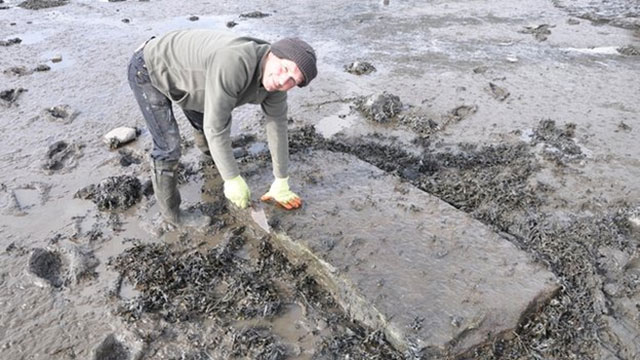It looks like you're using an Ad Blocker.
Please white-list or disable AboveTopSecret.com in your ad-blocking tool.
Thank you.
Some features of ATS will be disabled while you continue to use an ad-blocker.
17
share:
An interesting item popped up on my feed about the discovery of the not-quite-final resting place of the
Torryburn Witch and admittedly, I'd never heard of the Torryburn Witch. A quick search on Google turned up the following (very concise) account of her
story on The Fife Post:
You'd think the devil could have found a more lusty girlfriend but then again maybe he appreciates a woman with a bit more experience! I say girlfriend because according to the records of her confession, this was no one-time romp in the cornfield but rather a seven year affair. While these sorts of stories are interesting (and depressing), what really fascinated me was how she was buried and what later became of her remains — well some of her remains. From Cult of the Weird:

Interest piqued, I proceeded to the original BBC article and it turns out there was a bit more to the story!
As mentioned in one of the excerpts above, some enterprising ghoul dug up her skull and in the 19th century and it ended up for a time at the St. Andrews University Museum where like many curious artifacts, it later disappeared (really, who can keep track of these things?!) but here's a photo:

Perhaps a 20th century occultist made off with it? Maybe the devil reclaimed it in the dark of night and its off somewhere, embarking on new amorous adventures!
In the small village of Torryburn in the West of Fife in the year 1704, an old woman, Lillias Adie, was accused of bringing ill health to one of her neighbours, a certain Jean Nelson. Summoned before the ministers and elders of Torryburn church, poor old confused Lillias confessed that she was indeed a witch. She told the grim faced committee of church elders that she had met the Devil in a cornfield and had accepted him as her lover and master. The terrified woman described how she and the devil had led many others, whom she named, in a wild heathenish dance. According to Lillias a strange blue unearthly light had appeared and had followed the dancers round the cornfield, her tales grew wilder and wilder and were eagerly accepted as proof of her dealings with the Devil. Lillias was, according to the official records, “burnt within the sea mark”.
You'd think the devil could have found a more lusty girlfriend but then again maybe he appreciates a woman with a bit more experience! I say girlfriend because according to the records of her confession, this was no one-time romp in the cornfield but rather a seven year affair. While these sorts of stories are interesting (and depressing), what really fascinated me was how she was buried and what later became of her remains — well some of her remains. From Cult of the Weird:

She was buried in the muck of the coast with a large rock slab over her, most likely to prevent her corpse being reanimated by the devil to have sex with other witches.
Sometime in the late 19th century, her skull and other bits were dug up and sold. Her skull ended up in the St Andrews University Museum, where it was photographed before being lost, much like the grave itself.
Interest piqued, I proceeded to the original BBC article and it turns out there was a bit more to the story!
So they buried her deep in the sticky, sopping wet mud of the foreshore - between the high tide and low tide mark - and they put a heavy flat stone over her.
But why?
In previous cases, people wanted rid of dead witches as cheaply as possible - dumping them naked in pits at the foot of the gallows. Why go to such bother to bury Lilias?
One possibility is that Lilias killed herself.
Right up to the 19th Century suicide victims were buried this way on the shore, outside consecrated ground.
This seems strange and barbaric to us now, but it was believed that suicide was a terrible crime against God, inspired by the devil.
Worse, it was believed people who died in this way were in danger of becoming revenants - corpses of bad people who had died a bad death, who then came back from the grave to torment the living.
Demonologists believed that such walking corpses were real and possessed by the devil, who animated them to do things like have sex with witches.
As mentioned in one of the excerpts above, some enterprising ghoul dug up her skull and in the 19th century and it ended up for a time at the St. Andrews University Museum where like many curious artifacts, it later disappeared (really, who can keep track of these things?!) but here's a photo:

Perhaps a 20th century occultist made off with it? Maybe the devil reclaimed it in the dark of night and its off somewhere, embarking on new amorous adventures!
edit on 2014-10-28 by theantediluvian because: (no reason given)
originally posted by: theantediluvian
She was buried in the muck of the coast with a large rock slab over her, most likely to prevent her corpse being reanimated by the devil to have sex with other witches.

Is this a thing?
Oh, ye olden times... where animals and plants got put on trial and people were pants on head silly.
edit on 28-10-2014 by Septimus because:
(no reason given)
Damned devils. I mean spirits. I mean fairies. No wait, I mean aliens. Ugh, stupid keyboard, I meant mass hysteria. No, wait, Jungian Archetypes of
the Universal Subconscious.
Thanks, OP...fascinating stuff.
Thanks, OP...fascinating stuff.
originally posted by: theabsolutetruth
a reply to: Septimus
I grew up in rural Scotland, be assured there are still folks that think like that, you only need wear the wrong colour of tights to be called a witch.
I live in Scotland now and eh that's not true....
originally posted by: theabsolutetruth
a reply to: Septimus
I grew up in rural Scotland, be assured there are still folks that think like that, you only need wear the wrong colour of tights to be called a witch.
My favourite story is about the drunk who was going home from the pub late at night, and walking along a country road next to fields. Then he would a sheep coughing (which sound just like a human) and come to the conclusion that the devil was following him home
She had a seven-year affair with the devil? In some places this would be a common law marriage (as the devil is in the details).
a reply to: theantediluvian
I wonder if the hapless old women actually owned her property which presumably would have been claimed by the church on her death - see anything loaded against her in her trial?
I wonder if the hapless old women actually owned her property which presumably would have been claimed by the church on her death - see anything loaded against her in her trial?
new topics
-
Sepultura - Territory - With New Drummer Greyson Nekrutman
Music: 38 minutes ago -
Carry On!
Short Stories: 58 minutes ago -
This should be plastered all over the airwaves
Mainstream News: 6 hours ago -
Oh, Good Gosh. “Kremlin Warns Stay Away from Greenland.”
World War Three: 8 hours ago -
Archbisop Vigano Warns of Deep State and Deep Church
New World Order: 8 hours ago
top topics
-
This should be plastered all over the airwaves
Mainstream News: 6 hours ago, 19 flags -
Archbisop Vigano Warns of Deep State and Deep Church
New World Order: 8 hours ago, 11 flags -
Oh, Good Gosh. “Kremlin Warns Stay Away from Greenland.”
World War Three: 8 hours ago, 11 flags -
Fire insurance in LA withdrawn months ago
General Conspiracies: 16 hours ago, 9 flags -
A Flash of Beauty: Bigfoot Revealed ( documentary )
Cryptozoology: 14 hours ago, 7 flags -
Carry On!
Short Stories: 58 minutes ago, 1 flags -
Sepultura - Territory - With New Drummer Greyson Nekrutman
Music: 38 minutes ago, 0 flags
active topics
-
This should be plastered all over the airwaves
Mainstream News • 41 • : NoCorruptionAllowed -
The Acronym Game .. Pt.4
General Chit Chat • 1042 • : tinkerbell99 -
-@TH3WH17ERABB17- -Q- ---TIME TO SHOW THE WORLD--- -Part- --44--
Dissecting Disinformation • 3985 • : ORRED -
Judge rules president-elect Donald Trump must be sentenced in 'hush money' trial
US Political Madness • 109 • : matafuchs -
Los Angeles brush fires latest: 2 blazes threaten structures, prompt evacuations
Mainstream News • 340 • : NoCorruptionAllowed -
Trump says ownership of Greenland 'is an absolute necessity'
Other Current Events • 152 • : matafuchs -
Carry On!
Short Stories • 1 • : Dalamax -
Oh, Good Gosh. “Kremlin Warns Stay Away from Greenland.”
World War Three • 28 • : Dalamax -
Sepultura - Territory - With New Drummer Greyson Nekrutman
Music • 0 • : gortex -
Candidate TRUMP Now Has Crazy Judge JUAN MERCHAN After Him - The Stormy Daniels Hush-Money Case.
Political Conspiracies • 2186 • : Oldcarpy2
17
